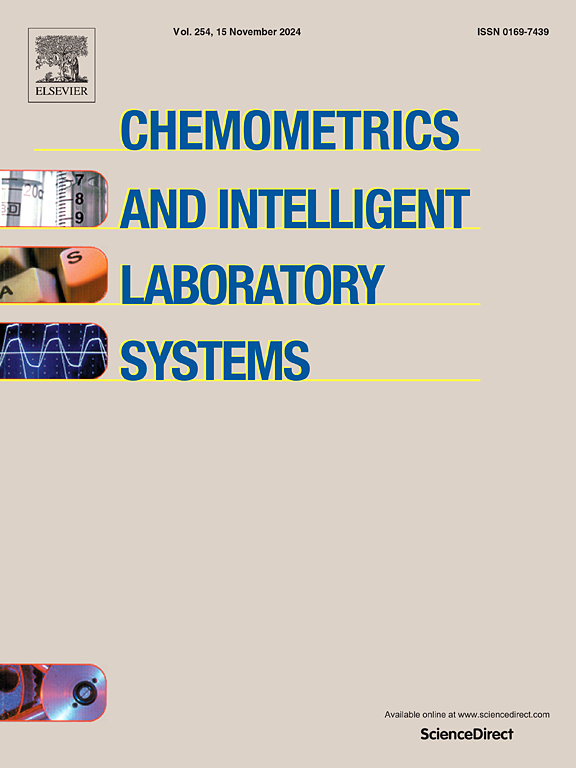A novel machine-learning approach to unlock technical lignin classification by NIR spectroscopy - bench to handheld
IF 3.8
2区 化学
Q2 AUTOMATION & CONTROL SYSTEMS
Chemometrics and Intelligent Laboratory Systems
Pub Date : 2025-06-11
DOI:10.1016/j.chemolab.2025.105467
引用次数: 0
Abstract
In this research, the utilization of near-infrared (NIR) spectroscopy in conjunction with advanced machine learning methods is investigated for categorizing technical lignins obtained from different biomass sources and industrial procedures. Technical lignins, such as kraft, organosolv and lignosulfonates, have different chemical compositions, which continue to make uniform characterization and application in sustainable sectors extremely difficult. Fast, universally accessible analytics combined with data analysis is still an open question. For the first time three distinct NIR spectrometers—a high-performance benchtop system, a mid-priced compact device, and an economical handheld unit—were utilized to record NIR spectra of 31 unique lignin samples. The spectra underwent pre-processing through standard normal variate (SNV) transformation and Savitzky-Golay derivatives to amplify spectral features and decrease noise. Principal component analysis (PCA) was employed to reduce data complexity and extract crucial characteristics for classification purposes. Subsequently, four machine learning algorithms—Support Vector Machines (SVM), Gaussian Naive Bayes (GNB), Gaussian Process Classification (GPC), and Decision Tree Classification (DTC)—were implemented for the classification of the lignin samples. The DTC model exhibited the highest accuracy among them across different spectrometers. Although the benchtop spectrometer produced the most precise outcomes, the compact NeoSpectra system also displayed potential as a cost-efficient option. Nonetheless, the restricted spectral coverage of the handheld NIRONE spectrometer resulted in reduced classification accuracy. Our discoveries highlight the capability of NIR spectroscopy, combined with robust data analysis techniques, for the swift and non-destructive classification of technical lignins, facilitating their improved utilization in sustainable fields.
一种新的机器学习方法解锁技术木质素的近红外光谱分类-台式手持
在本研究中,利用近红外(NIR)光谱结合先进的机器学习方法,研究了从不同生物质来源和工业过程中获得的技术木质素的分类。技术木质素,如硫酸盐、有机溶剂和木质素磺酸盐,具有不同的化学成分,这继续使统一表征和在可持续部门的应用变得极其困难。快速、普遍可访问的分析与数据分析相结合仍然是一个悬而未决的问题。首次使用三种不同的近红外光谱仪-高性能台式系统,中等价格的紧凑型设备和经济型手持设备-来记录31种独特木质素样品的近红外光谱。通过标准正态变量(SNV)变换和Savitzky-Golay导数对光谱进行预处理,放大光谱特征,降低噪声。采用主成分分析(PCA)降低数据复杂度,提取关键特征进行分类。随后,采用支持向量机(SVM)、高斯朴素贝叶斯(GNB)、高斯过程分类(GPC)和决策树分类(DTC)四种机器学习算法对木质素样本进行分类。DTC模型在不同的光谱仪上表现出最高的精度。虽然台式光谱仪的结果最为精确,但紧凑的NeoSpectra系统也显示出作为一种经济高效的选择的潜力。尽管如此,手持式NIRONE光谱仪的光谱覆盖范围有限,导致分类精度降低。我们的发现突出了近红外光谱与强大的数据分析技术相结合的能力,可以快速和无损地分类技术木质素,促进其在可持续领域的更好利用。
本文章由计算机程序翻译,如有差异,请以英文原文为准。
求助全文
约1分钟内获得全文
求助全文
来源期刊
CiteScore
7.50
自引率
7.70%
发文量
169
审稿时长
3.4 months
期刊介绍:
Chemometrics and Intelligent Laboratory Systems publishes original research papers, short communications, reviews, tutorials and Original Software Publications reporting on development of novel statistical, mathematical, or computer techniques in Chemistry and related disciplines.
Chemometrics is the chemical discipline that uses mathematical and statistical methods to design or select optimal procedures and experiments, and to provide maximum chemical information by analysing chemical data.
The journal deals with the following topics:
1) Development of new statistical, mathematical and chemometrical methods for Chemistry and related fields (Environmental Chemistry, Biochemistry, Toxicology, System Biology, -Omics, etc.)
2) Novel applications of chemometrics to all branches of Chemistry and related fields (typical domains of interest are: process data analysis, experimental design, data mining, signal processing, supervised modelling, decision making, robust statistics, mixture analysis, multivariate calibration etc.) Routine applications of established chemometrical techniques will not be considered.
3) Development of new software that provides novel tools or truly advances the use of chemometrical methods.
4) Well characterized data sets to test performance for the new methods and software.
The journal complies with International Committee of Medical Journal Editors'' Uniform requirements for manuscripts.

 求助内容:
求助内容: 应助结果提醒方式:
应助结果提醒方式:


